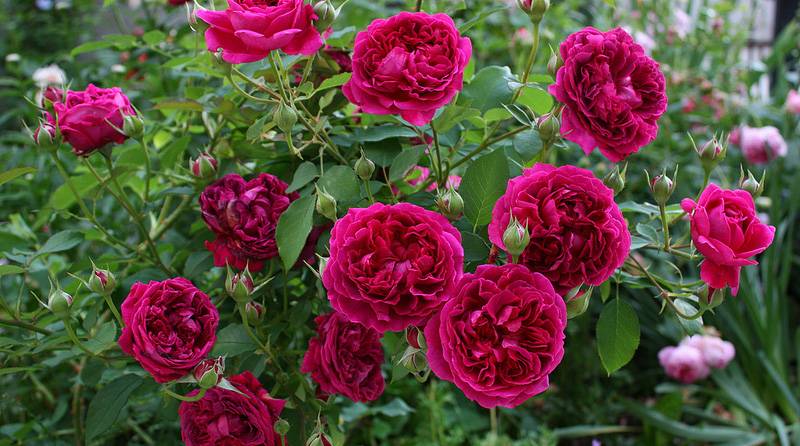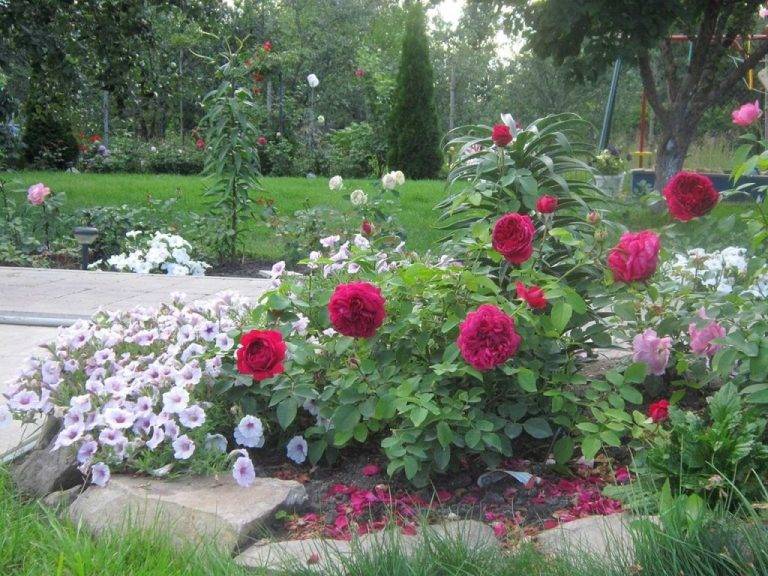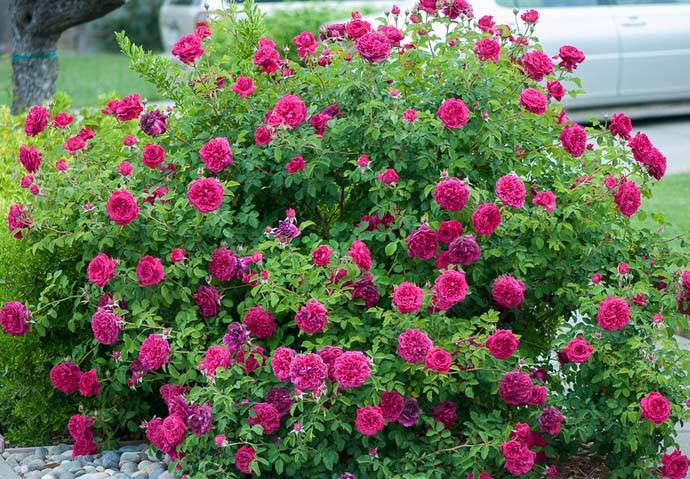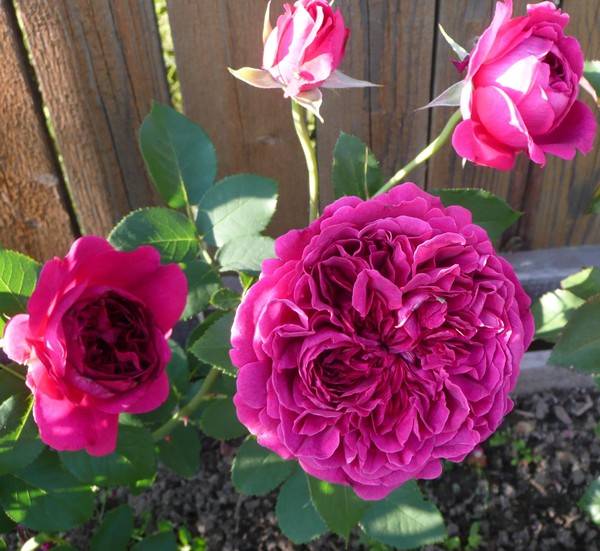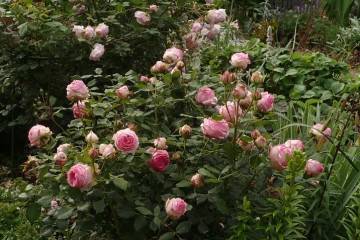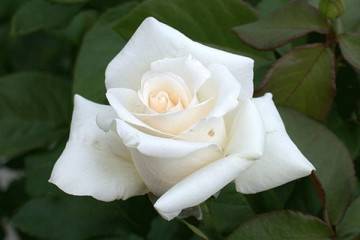Rose William Shakespeare - characteristics of varietal bush
Content:
The William Shakespeare variety is one of the world class masterpieces. It combines luxurious appearance and undemanding care. The grower is able to enjoy beautiful and long-lasting flowering without undue effort.
Rose William Shakespeare and William Shakespeare 2000
British breeder D. Austin crossed various types of roses for many years and in 1987 received a variety named after W. Shakespeare. To obtain it, he crossed the floribunda with a hybrid tea variety.
The result is a rose that has a unique scent and a long flowering period. However, this plant was vulnerable to dangerous diseases: powdery mildew, rust.
Brief description and characteristics
Rose William Shakespeare has large flowers of bright red color. They look a bit like peonies. The rose bush is tall and lush. Green leaves have a matte surface. The buds are shaped like a bowl and have a diameter of 15 cm.
The flower is lush and dense. The number of petals in one bud can reach hundreds. Flowers are arranged in tassels. It is impossible to see the yellow center of the flower because of the petals. These flowers have an exquisite aroma of an old rose with a slight hint of violet.
Advantages and disadvantages of the variety
The important advantages of the William Shakespeare variety are stylish and beautiful flowers and an original refined aroma. As a disadvantage, flower growers note the weak winter hardiness of the plant.
Use in landscape design
William Shakespeare rose is widely used in landscaping. She looks good both in flower arrangements and in a single planting.
Often used together with aconite, delphinium. This composition is used to decorate flower beds and garden paths. It is used as decoration for gazebos and verandas.
Growing a flower
Proper planting in the ground will allow you to grow a strong, beautiful and viable plant. If done correctly, it will delight with luxurious flowers for many years.
For planting, seedlings are usually used. However, gardeners often use cuttings propagation. To plant them in their permanent place, they must first take root.
Seat selection
For cultivation, it is recommended to choose a place that is well lit by the sun. It is important not to use low-lying places for this. The rose does not tolerate well when moisture stagnates in the soil.
How to prepare the soil and flower for planting
Before planting, the seedlings of this bush variety are placed in water for 5 hours. It is recommended to add a root growth stimulator to it.
It is necessary to inspect the planting material and remove dried roots or shoots. If there are too long, then they should be shortened.
It is necessary to dig holes for the seedlings in advance. They should, according to the description, have a depth of 50 cm, and a width and length of 40 cm.
Planting procedure step by step
To plant a rose of this variety, you must do the following:
- A drainage layer is poured onto the bottom of a previously prepared hole.
- A special mixture is poured on top. For its preparation, they take peat, sand, mullein and fertile soil in a ratio of 1: 2: 3: 2. Then stir thoroughly.
- When planting a seedling, you need to straighten the roots. It is placed at such a height that the neck is 2-4 cm below ground level.
- The hole is covered with soil, then the soil is slightly compacted.
After planting, water and sprinkle the rose abundantly.
Plant care
This plant is unpretentious. In order for it to please with beautiful flowering, it is necessary to take care of it and provide it with everything you need.
Watering rules and humidity
For watering a climbing Shakespeare rose, you need to use settled and warm water. For each bush, you need to spend 10 liters weekly.
When the hot summer comes, the rose needs more moisture than before. Then watering is necessary every three days. In addition, foliage spraying can be carried out additionally.
It is important that the soil around the bush does not dry out. In this case, water as soon as possible. The soil is not allowed to be waterlogged.
After watering, loosening is carried out to prevent the formation of a dense soil crust.
Top dressing and soil quality
During the first year after planting the Shakespeare park rose, there are enough nutrients introduced into the hole. The next feeding is carried out during the period when the buds ripen in the second year of growth. Another will be required in early spring in the third year of the rose's life.
It is necessary to regularly weed and loosen the soil under the bushes.
Pruning
After the end of the winter cold, pruning is needed: dried and diseased shoots are removed. If there are thin and weak branches, they are shortened in half, the rest are left half the length.
When pruning, which is done in summer, the stems, which have not become lignified by this time, and the faded buds are removed.
Another pruning is done in late autumn. Its purpose is to prepare for winter. In this case, a third is cut off from the shoots.
Features of wintering a flower
English rose William Shakespeare weakly resists frost. She needs good shelter in winter. To do this, do the following:
- Hilling is carried out with a height of 30-40 cm. In this case, dry earth mixed with humus is used.
- Create a wireframe. With the onset of cold weather, covering material is placed on it. To do this, you can use a plastic wrap laid out in 2-3 layers.
- Spruce paws are placed on top to create an air cushion.
Blooming rose
Rose William Shakespeare blooms several times during the season. The first flowering is profuse, it occurs in June-July. After that, with short breaks, several more waves of flowering follow.
A period of activity and rest
The time of active growth and flowering begins from the moment when the snow melts. The last flowering ends in August. From September until winter ends, the rose has a dormant period.
Care during and after flowering
During flowering, with an interval of 17-20 days, it is necessary to apply top dressing. You can use standard rose fertilizer for this. It is important that the plant receives at this time a sufficient amount of potash and phosphorus fertilizers, which are necessary for high-quality and abundant flowering.
What to do if it does not bloom
The lack of flowering in most cases is associated with violations of the rules of care. The reasons, for example, may be insufficient watering, lack of nutrients, insufficiently loose soil. If a problem is found, you need to carefully follow the requirements of plant care in the future.
Flower propagation
To grow a flower, you cannot use seeds, as they do not retain varietal characteristics. Store-bought seedlings or cuttings are usually used.
Cuttings are harvested during the time preceding the first flowering, which occurs in June-July. After that, they are germinated, and after wintering, they are planted in a permanent place.
For the cutting, a part of the shoot 10-15 cm long is used. It is necessary that there are 3-4 buds on it. The stalk is cut from the shoot of the first flowering wave. In this case, the upper cut should be perpendicular, and the lower one - at an angle of 45 °. The lower leaves need to be removed. Germination is performed as follows:
- The lower part is placed for 4 hours in a growth stimulant solution.
- They are planted in a greenhouse or covered with plastic bottles.
- Provide lighting, watering. Ventilate regularly.
- Provide a temperature of 22-25 ° C.
For the winter, cuttings are covered. In severe frosts, they are grown indoors. In early spring, they are transplanted to a permanent place.
Diseases, pests and ways to control them
If the Shakespeare rose suffers from powdery mildew, the damaged parts must be trimmed and burned. It is important to do this so that healthy shoots are not infected. After pruning, the bush is treated with a solution of copper sulfate (30%) or obtained from laundry soap.
If rust is found, the plant should be carefully examined. All places where there are traces of it must be cut off and burned. For spraying, a decoction of nettle or wormwood, a copper-soap composition or a solution of copper sulfate (30%) can be used.
In any case, the variety combines beautiful flowers, exquisite aroma and easy care. Thanks to this, the rose William Shakespeare can decorate any flower bed.
